Hoshino Yukinobu
This time, we go behind the scenes of manga creation with sci-fi master Hoshino Yukinobu. Marvel at the power of the pen as Hoshino works on incredible ocean scenery for his epic, Kaitei.
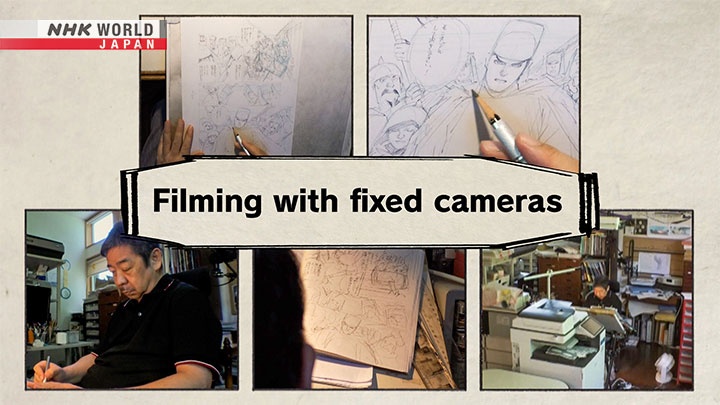
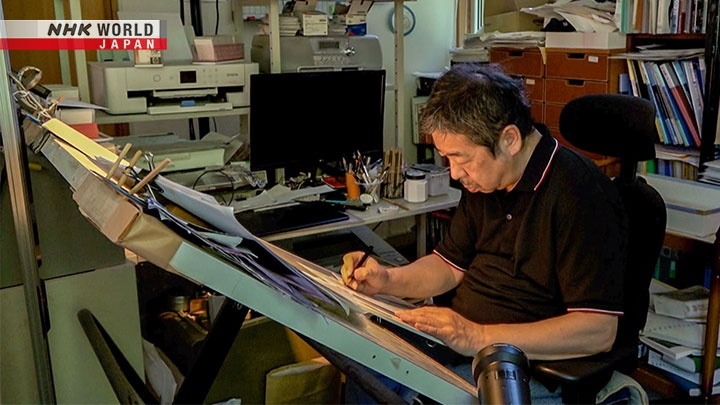
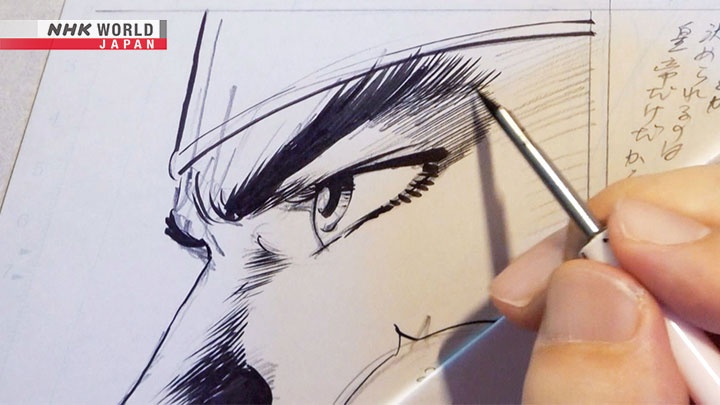
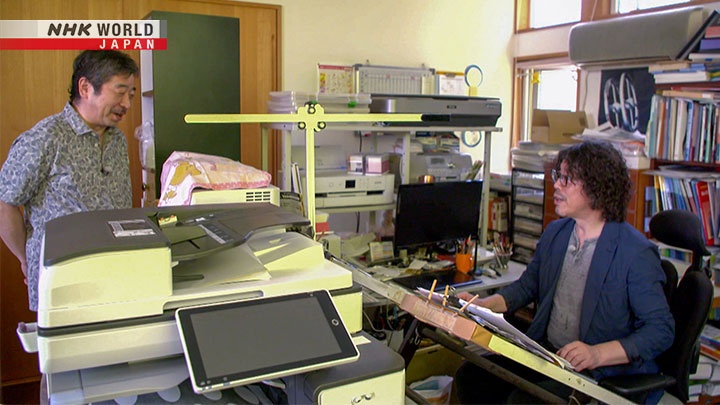
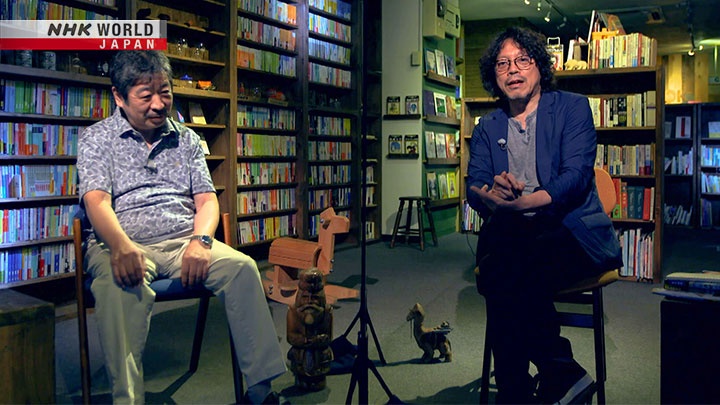
Transcript
Like I've always said,
the nib of a pen
is packed with magic.
I've been fascinated with that magic
for over 50 years now.
And I'm still figuring out
how to use it.
Creating mood with pencils is easy
because you can shade as needed.
That's hard to do with pens.
If possible, I would love to use
a brush pen for everything.
Manga - where drama is created with just the tip of a pen.
In this program, we take you behind the scenes of where manga is made and explore the craft.
The idea came from Urasawa Naoki.
The famous manga artist has released hits in a variety of genres.
Urasawa spent years studying works by numerous manga artists
and went through a lot of trial and error to solidify his artistic style.
Certain lines can only be made
by mastering classic techniques.
This type of craftsmanship formed
throughout Japanese manga history.
Seeing impressive line work
makes you want to imitate the style.
This time, our guest is an incredibly talented artist Urasawa has long admired.
Hoshino Yukinobu, a master of sci-fi manga, made his debut eight years before Urasawa Naoki.
One of Hoshino's definitive works is "Blue Hole."
In the manga, a mysterious blue hole discovered at the bottom of the ocean near Madagascar
leads to 65 million years in the past when dinosaurs ruled the Earth.
The thrilling sci-fi came out before "Jurassic Park" released in Japan.
The "Professor Munakata" series shows Hoshino's skill in mystery, as well.
The story follows a folklorist as he unravels secrets behind strange legends across Japan.
The British Museum held an exhibition of Hoshino's art,
a first for any Japanese manga artist, proof of his critical acclaim.
What drives Hoshino to create manga?
I feel there was a time when most manga
were science fiction.
Tezuka Osamu put out a lot of sci-fi.
But he also worked in other genres
like historical fiction and adventure.
Still, sci-fi was always at his core.
Our cameras captured Hoshino as he worked over four days.
Hoshino has honed his craftsman-like artistic abilities to add as much realism to a story as possible.
Hoshino currently creates manga in Sapporo, Hokkaido.
This must be it.
Our first stop is Hoshino's workspace.
He really is a fantastic artist.
Prepare yourself.
Surprisingly, this is Urasawa's first time to meet Hoshino, so he's a bit nervous.
Hello!
- It's nice to meet you.
- Nice to meet you, too.
- I'm Urasawa.
- I'm Hoshino.
What a lovely office.
You didn't have to come so far.
I love this space.
Hoshino works on the third floor of his house.
Pens and other tools are neatly arranged in easy-to-reach places.
Hoshino likes to work with a drawing board on an inclined desk.
Urasawa couldn't help himself.
Oh! I like this!
Not bad at all.
The incline makes a big difference.
It's a bit more stable.
I like the distance.
- Great for older people.
- You can get up close.
Old eyesight is a pain.
The two artists moved the conversation to a used bookstore in Sapporo.
You are an incredibly skilled artist.
But many readers see you mainly
as a historical sci-fi writer.
For manga artists like me,
you are an artistic legend!
I want everyone to notice
that part of your career, too.
I hope our conversation can show people
that you are not only a sci-fi master,
but a truly incredible artist.
Thank you for saying that.
We placed cameras in Hoshino's workspace so as not to disturb his process.
Now it's time to watch a creative master at work!
Day one. Hoshino creates a rough draft for the entire manga.
He uses a blue-colored pencil to draft the overall layout.
Then starts drafting with a pencil.
Hoshino is currently working on "Kaitei," his first long-form historical manga.
The story follows Zheng He, a historical figure from China's Ming Dynasty in the 15th century.
It is said he led large fleets and sailed as far away as Africa,
long before famous adventurers like Columbus and Magellan.
Hoshino is working on the story's turning point when Zheng He decides to confess something to the emperor.
The scene plays out across three panels.
Have you watched yourself work before?
No.
How is it?
I thought I was working fast,
but I took my time.
I'm really dragging my feet.
You're searching for the perfect line,
but every line already feels perfect.
I wouldn't say that.
You imagine how it looks,
and then move the pencil with precision.
Hm.
Next is the large left panel.
It looks like Hoshino's drawing an eye.
I love the nuanced pencil work.
A part of me wishes
I could make this the manuscript.
Pens make lines feel stiff.
I don't like tracing over a drawing.
I agree.
That's why I prefer to use brush pens.
It adds nuance.
Who were your early influences?
Kuwata Jiro.
He made such beautiful lines.
His manga "8 Man" is a true classic.
I can feel his essence in your work.
His artwork was so stylish back then.
Yes. Very cool.
It was different from gekiga manga.
If Kuwata Jiro kept digging deeper,
his art might have ended up like this.
Is that so?
A rough draft that looks ready to print. Wow.
Hoshino created nine pages of rough drafts all in one day.
The entire process took ten hours.
Day two. Time for inking.
But first, Hoshino sets up an MD player, and starts playing -
- Rakugo?
A rakugo recording.
When working on the story,
rough drafts, or storyboarding,
there's a lot you need to think about.
Listening to music is ideal.
But once I start to ink, my mind is free.
So I like to listen to things
with words, like rakugo.
Using a thin brush pen, Hoshino starts with the outline of Zheng He's look of resolution.
Brush pens are great for drawing both thick and thin lines.
Hoshino adjusts thickness as he inks.
Hoshino uses thick lines for eyes and eyebrows to express strength.
The lines have a nice touch.
Better than pens.
With stiff pen nibs, you press down.
But for soft brushes, you float.
You use muscles in different ways.
Brushes are more demanding.
Maintaining distance is key.
It's all about how you pull the brush.
For the nose's shadow-
-Hoshino goes with solid black!
I don't have the courage to do this.
But you can already see
the final image in your head.
I've always loved how you use blacks
to shadow noses angled away.
And Professor Munakata's cape.
It's all black just like Batman.
Your solid blacks are so masterful.
You don't need things like highlights.
Solid blacks contain strength.
Plus, it hides whatever is beneath.
It adds fear to villains like Darth Vader.
Only revealing the shape.
- Still, you work so fast.
- You think so?
There's no hesitation.
Everyone else hesitates a bit more.
Hoshino changes pens.
A mapping pen.
It's pretty loud.
Hoshino uses the fine lines of a mapping pen for detailed face shading.
The process is mesmerizing.
Wow.
It all comes together beautifully!
I don't know...
Many artists spend days working on faces.
I bet there are people watching
who are shocked at how fast you work.
"How does he make it look so easy?"
And all while listening to rakugo!
Hoshino expresses the hat's stiff texture with a g-pen.
It took just 25 minutes for Hoshino to ink these three frames.
Zheng He - determined to confess something to the emperor.
He stares out into the distance.
The solid blacks strengthen his expression, filling the frame with Zheng He's determination.
Hoshino Yukinobu was born and raised in Hokkaido.
Several key encounters led him to create manga.
At six years old, he discovered a manga by Tezuka Osamu.
The sci-fi genre fascinated young Hoshino.
At ten, he began creating his own manga.
Hoshino based it on an existing work, designed the characters and submarine, and created the panel layout.
Another sci-fi work heavily influenced Hoshino.
"2001: A Space Odyssey."
Stanley Kubrick's sci-fi masterpiece has resonated across film history.
When I saw "2001: A Space Odyssey,"
I was in my early teens.
It was a very formative experience.
It was so different from sci-fi movies
about rockets flying around in space
making lots of noise.
The silence in the film made it feel
like you were actually in space.
That experience is
at the core of all I do.
Hoshino studied at an art university.
He focused on the simple lines of Japanese painting.
Western art is about light and shadow.
But Japanese painting use
lines for expression, not shadows.
In that way, it's very similar to manga.
You don't see contoured lines in nature.
But they're so much fun to draw.
I think Japanese
view the world with lines.
For Japanese art and manga,
lines must be able to express
texture and weight.
After two years, Hoshino dropped out of university and moved to Tokyo to become a manga artist.
At 21, he created "Haruka Naru Asa."
Tezuka Osamu, one of Hoshino's idols, praised the manga.
Hoshino went on to release a variety of sci-fi manga,
all with well-thought-out storylines and masterful artwork.
Even today, Hoshino continues to give realism to stories about unknown worlds.
You are a sci-fi master.
It makes sense your works
feel high definition.
High definition?
It's like you draw everything
in high resolution.
Filling up every part of a panel
must be so much work.
But readers love to examine every detail,
wondering how it was all made.
Fans like me must stress you out.
You don't want people to look at details.
Exactly.
But you drew it. It can't be helped.
"Kaitei," the manga Hoshino is working on this time, is sprinkled with sci-fi elements.
Typical of a Hoshino work, the story is about 80% truth and 20% fiction.
Back to work.
Hoshino is working on the Great Ocean, the story's main setting.
A three-eyed monk tells Zheng He,
"Like swelling waves inside of eternity, everything changes in an instant."
Hoshino will use a large, two-page spread.
How will he express the pivotal moment?
This is an amazing page.
You just go straight for it.
There is a rough layout in blue.
Just the shape.
This is very educational footage
for any future manga artist.
The panel only features a rough outline of the horizon.
Regardless, Hoshino goes straight to inking the page.
A Hoshino manga always has
beautiful scenes of nature.
So many rocks, waves, and mountains.
Way too many to count.
Maybe.
I even used a magnifying glass to study
how you made the surfaces of your rocks.
At first, it was all just squiggly lines.
Still, take Tezuka Osamu's "Phoenix."
I can't draw weathered rocks
and crumbling boulders like him.
The movement is so natural.
It's like the rocks are characters.
That's right.
Forming a rock's shape is like creating a character.
I don't think Tezuka studied photos,
but his rocks are still so attractive.
Hoshino's detailed brush lines slowly come together to form the ocean -
without a single do-over.
For natural objects like trees,
accidental lines from brush strokes
make them feel even more natural.
- Yes.
- It doesn't feel artificial.
Some lines might not end up as expected,
but I pay no mind and keep going.
It's as if Hoshino takes the images in his head and puts them directly on white paper.
You can't program a robot to do this.
It's too random for a computer to copy.
The sense of randomness.
Including mistakes made by human hands.
A vast ocean fills the panel.
Still, Hoshino continues to draw with thin brush strokes-
It looks like he's adding waves in the distance.
Hoshino changes to a mapping pen.
It baffles me how you weave together
all these mountains and valleys so well.
You can't see the other side,
but you can still feel it.
It's so satisfying.
Wow. Not much else to say.
And then Hoshino starts coloring the sky above the waves black!
What a bold choice!
I started to get lazy.
Yes! But that is a big part, too.
If you were working with CG,
you wouldn't have to make that decision.
You must accept your own laziness.
Yes. In a way, laziness equals design.
Hoshino adds gradation to the solid-black sky.
Oh!?
This is one of your secret techniques.
You could get paid well for this.
Wow.
It looks perfect.
Twenty minutes and inking is complete.
Layered ocean waves and a dark sky that stretches out into the distance-
Hoshino's ocean imagery foreshadows the difficulties ahead.
Although the inking process is fast, Hoshino spends time on the scenario and storyboards.
A 24-page episode takes about ten days to finish.
During this process, Hoshino decides on details like character poses and expressions,
which Urasawa says is enough for a rough draft.
I prefer to use "storyboard"
instead of the Japanese "name."
Storyboarding.
It's a filmmaking term.
Movies are moving pictures.
The storyboard is the movement memo.
There needs to be movement.
The sense of speed in the storyboard
creates momentum in the story.
But the final draft has a formal feel,
and the movement stops.
Next, Hoshino starts work on the final page.
This is the storyboard.
The scene is of Zheng He returning to Ming after his first voyage.
But when Hoshino created the rough draft-
The image ended up looking different from the storyboard.
In the storyboard, we're looking up.
Yes.
You changed the angle.
The title image was from the same angle.
I wanted the ending to be different.
And still, no hesitation!
Next, Hoshino starts drawing the ships.
He moves quickly - all without using any reference materials.
It looks like Hoshino decided to give the scene more depth.
Next up: inking.
Hoshino starts with Zheng He's face using a G-pen.
One thing that always blows me away
is how you can draw people and images
from so many different angles.
Is that so?
These scenes feel natural
thanks to drone technology.
In the past, if you filmed a movie
from an angle like this one,
it wouldn't feel natural.
Same with manga.
You wonder where the camera is placed.
For interiors, is it in the ceiling?
You can't help but notice those things.
But drones can shoot in any position,
from the floor to the ceiling.
It's easier to use angles like these now.
Having real-life devices
that can make similar images
helps our brains visualize things.
Hoshino picks up a brush pen and starts work on the cloak.
He colors it solid black with bold strokes.
I can't believe you don't need a draft
to add gloss to the cloak like this!
Most artists add those to the draft.
But you don't.
The bold strokes feel so good!
The confident strokes must mean Hoshino already has a clear image in his head.
Next, speed lines around the ships, with the same brush pen.
The hand-drawn lines fill the page with momentum that pushes the boats forward.
Hoshino adds finishing touches with a mapping pen.
The thin lines give the boats even more speed.
Two hours later, and the page is finished.
Zheng He and his ship head to meet with the emperor in Ming.
The dynamic composition is full of movement,
filling the audience with anticipation for the next episode.
As we filmed, Hoshino showed us a special room in his house.
This is the library.
Hoshino's library is home to over 10,000 volumes.
Over the years, Hoshino has collected books that interest him,
from history to folklore, science, and space.
Just how many books do you read?
Reading must be all you do!
Not exactly.
- You like reading. - Yes.
- And you can't stop. - That's right.
You really need to enjoy reading
with all the research it takes!
I learned so much history in "Kaitei."
You take us on a mysterious journey,
full of telepathic monkeys
and proto-humans.
Your worlds draw me in
and make me think it all truly existed.
I can't tell between fact and fiction!
Hoshino compiles the ideas that come to him from reading into a notebook.
Fragments slowly come together to form a story.
For example, Hoshino connected volcanoes with the Japanese myth of Susanoo to create "Yamataika."
The historical sci-fi poses questions about the roots of the Japanese people.
Hoshino's daily research helps these stories feel like actual history.
Back to the studio to work on a key scene.
Zheng He strengthens his resolve after recalling a childhood memory.
Hoshino starts with the rough draft.
I'm amazed at how fast you are,
even when drawing young children!
This really surprised me.
You know exactly how the muscles look.
It's perfect.
I don't know how you do it.
This is ready to go. No inking needed.
Nobody would say no.
Zheng He was a eunuch.
Hoshino added a fictional backstory to explain why.
Zheng He was born an ethnic minority and his father was killed by the Ming Dynasty.
To survive, Zheng He chose to become a eunuch -
a tragic origin that pushes the story forward.
"Kaitei" is the story of a eunuch.
There's a deep sadness
unlike anything I've seen in your work.
How do you see it?
I don't understand why eunuchs existed
but I was curious and wanted to learn.
Having a character like that
lead a grand adventure felt special.
I wanted to depict his life at a scale
equal to the journey he embarked on.
That's a big part.
The final dream of a man who
lost everything is to see the world.
It's a very moving way to put things.
You are able to immediately understand
what pain and sadness look like.
Time to ink.
Hoshino expresses the boy's grief with a g-pen.
There's something romantic
about stories of the ocean.
He was at sea for 30 years.
And it wasn't an easy voyage.
When a boat is powered by the wind,
you must wait for the wind to blow.
That's why it takes so long.
At sea, you lose any concept of the earth.
Embarking with such little information
is quite romantic.
Hoshino inks the hair with thick strokes.
After two hours, Hoshino has finished the childhood flashback.
After losing everything, Zheng He's sadness fills the page.
He has only completed the first of seven voyages.
Zheng He's adventures will continue.
I just witnessed greatness.
I didn't expect so many compliments.
I can't help but marvel at the process.
I really admire your work.
I don't know how much longer I've got.
Maybe my last work should be sci-fi.
Or I could go back to "Munataka."
I'm thinking about my final act.